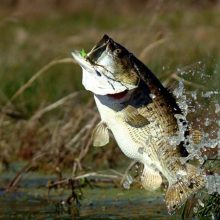This article may contain affiliate links. If you make a purchase after clicking on a link we may earn a small commission at no extra cost to you. As an Amazon Associate, I earn from qualifying purchases.
Lake Ontario Bass Fishing

With all the different baits and techniques on the market it’s easy to get confused, feel overwhelmed and lose sight of the simple pleasure of bass fishing.
If you are unsure if what tackle to use check out our guide Bass Fishing Rod Selection Guide.
Whether it’s tournament fishing or guiding on Eastern Lake Ontario and the St. Lawrence River, I employ three user-friendly techniques that my clients can easily master with a minimal amount of instruction.
Lake Ontario Bass Fishing
The first technique is drop-shotting. Drop-shotting is a simple variation of an old live bait rig where the weight is anywhere from three inches to three feet below the hook. I usually rig my weight about one foot below my Gamakatsu / wide gap#1 or #2 hook.
When fishing a drop shot rig it is fished vertically under the boat in water from 15 to 50 feet, but can be cast and slowly dragged or jigged back to the boat.
The key here is a slow presentation; the bait does not need a lot of action applied to it. Whether fished deep or fished shallow, maintain bottom contact. Let the weight bounce along the bottom as the bait seductively hovers over it. To rig the drop shot, tie a polymer knot, clinch knot, or whatever your personal favorite is, and leave a long tag end to attach to your weight.
Weights designed for drop-shotting have a clip on them that attaches to the line without having to be tied. Other weights will work, like split-shot, a pegged bullet sinker, or a regular bank sinker, but the clip-on style will slide off the line when hung on bottom so you won’t have to retie an entire rig.
My choice of baits for drop-shotting is usually minnow imitations in the three- to four- inch size. Kietechs’ Shad Impact was my personal favorite last season.
Rod and line choice for all three techniques is a spinning rod medium power with an extra fast action and 8- to 10- pound test fluorocarbon or monofilament line.
Another very effective bass-catching method is the wacky rig. My personal preference is the five inch Gary Yamamoto Senko with the hook impaled in the center of the body of the worm. I prefer a Gamakatsu 2/0 straight shank worm hook.
It seems to hold better in the fish’s mouth and I don’t seem to have as many come unbuttoned. I have tried the shorter shank finesse hooks and find I don’t seem to get the hook penetration that I get with a longer shank hook.
I stay with darker natural colors. When fishing a wacky rig, I don’t feel color is as important as it is with other techniques. Many times when I am tournament fishing I will put three different colors: green pumpkin, watermelon red flake, and black with blue flake in my pocket and blindly rebait my hook as needed.
When fishing a wacky rigged worm, simply cast the bait near visible cover like docks, rock piles, stumps or a weed edge and let it fall naturally on a semi-slack line without imparting any action to the bait.
The slow undulating action as the worm free- falls to the bottom is what triggers the strike. After the bait has reached bottom, which will take several seconds with this weightless presentation, snap your bait off the bottom about a foot and let it settle again. If no strike occurs, reel in and make another cast.
Wacky rig fishing is a real do-nothing technique requiring little angler skill, making it perfect for kids, novice anglers or anyone making the transition from live bait to artificial.
Wacky rigging and fishing a drop-shot rig will catch both largemouth and smallmouth bass. Dragging a tube bait is primarily a smallmouth technique that can easily be mastered and may put some of the biggest bass in the lake in your boat and is effective in shallow and deep water.
The action of the tube slowly crawling along the bottom and occasionally deflecting off of a rock, boulder, or wood structure will trigger a reaction strike from smallmouth hungry for crayfish. Tubes that resemble Gobies and crayfish in the three- to four-inch range in hues like green pumpkin, smoke, watermelon, and root beer with various flake combos are my preference.
Tube jigheads come in a variety of styles and sizes but I prefer a cylindrical shaped head with a 90-degree hook eye. It will kick out and deflect when it strikes an object, giving the bait a more erratic action.
It is important to have a quality hook that won’t straighten if a giant bass is hooked. The weight of the jighead will depend on factors such as depth, wind, and current.
Usually 1/8- to1/4- ounce jigheads are best for water less than 10 feet. I will go as heavy as 3/4- ounce if fishing very deep or in heavy current. Remember, when deciding how heavy a jighead to use that the tube should gently tick across the bottom, not dredge it.
Other techniques such as fishing a jerkbait in colder months from the shore can be quite successful.
Try these three techniques that anyone can master and enjoy the simple pleasure of bass fishing. Remember to release the fighter so others can experience the thrill of this beautiful game fish.
